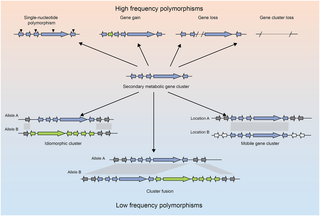PLOS Biology ( IF 7.8 ) Pub Date : 2017-11-17 , DOI: 10.1371/journal.pbio.2003583 Abigail L. Lind , Jennifer H. Wisecaver , Catarina Lameiras , Philipp Wiemann , Jonathan M. Palmer , Nancy P. Keller , Fernando Rodrigues , Gustavo H. Goldman , Antonis Rokas

|
Filamentous fungi produce a diverse array of secondary metabolites (SMs) critical for defense, virulence, and communication. The metabolic pathways that produce SMs are found in contiguous gene clusters in fungal genomes, an atypical arrangement for metabolic pathways in other eukaryotes. Comparative studies of filamentous fungal species have shown that SM gene clusters are often either highly divergent or uniquely present in one or a handful of species, hampering efforts to determine the genetic basis and evolutionary drivers of SM gene cluster divergence. Here, we examined SM variation in 66 cosmopolitan strains of a single species, the opportunistic human pathogen Aspergillus fumigatus. Investigation of genome-wide within-species variation revealed 5 general types of variation in SM gene clusters: nonfunctional gene polymorphisms; gene gain and loss polymorphisms; whole cluster gain and loss polymorphisms; allelic polymorphisms, in which different alleles corresponded to distinct, nonhomologous clusters; and location polymorphisms, in which a cluster was found to differ in its genomic location across strains. These polymorphisms affect the function of representative A. fumigatus SM gene clusters, such as those involved in the production of gliotoxin, fumigaclavine, and helvolic acid as well as the function of clusters with undefined products. In addition to enabling the identification of polymorphisms, the detection of which requires extensive genome-wide synteny conservation (e.g., mobile gene clusters and nonhomologous cluster alleles), our approach also implicated multiple underlying genetic drivers, including point mutations, recombination, and genomic deletion and insertion events as well as horizontal gene transfer from distant fungi. Finally, most of the variants that we uncover within A. fumigatus have been previously hypothesized to contribute to SM gene cluster diversity across entire fungal classes and phyla. We suggest that the drivers of genetic diversity operating within a fungal species shown here are sufficient to explain SM cluster macroevolutionary patterns.
中文翻译:

真菌物种内次生代谢基因簇中遗传多样性的驱动因素
丝状真菌会产生各种各样的次生代谢产物(SM),这些物质对于防御,毒力和交流至关重要。在真菌基因组的连续基因簇中发现了产生SM的代谢途径,这是其他真核生物中代谢途径的非典型排列。丝状真菌物种的比较研究表明,SM基因簇通常要么高度趋异,要么独特地存在于一个或少数几个物种中,从而阻碍了确定SM基因簇趋异的遗传基础和进化驱动力的努力。在这里,我们研究了66个世界性菌株的单种,即机会性人类病原体烟曲霉(Aspergillus fumigatus)中的SM变异。对全基因组种内变异的调查显示,SM基因簇中的5种一般变异类型:无功能基因多态性;基因增益和丢失多态性;整个群集的增益和损耗多态性;等位基因多态性,其中不同的等位基因对应于不同的非同源簇;和位置多态性,其中发现了一个簇,其基因组位置在菌株之间有所不同。这些多态性影响代表性A的功能。烟熏SM基因簇,例如那些涉及胶体毒素,烟曲霉,和庚二酸生产的基因,以及具有不确定产物的簇的功能。除了能够鉴定多态性(检测其需要广泛的全基因组同义性保护(例如,流动基因簇和非同源簇等位基因))外,我们的方法还涉及多种潜在的遗传驱动因素,包括点突变,重组和基因组缺失和插入事件,以及来自遥远真菌的水平基因转移。最后,我们在A中发现的大多数变体。烟熏先前已被假定对整个真菌类和门类的SM基因簇多样性有贡献。我们建议这里显示的真菌物种内遗传多样性的驱动程序足以解释SM集群宏观进化模式。











































 京公网安备 11010802027423号
京公网安备 11010802027423号